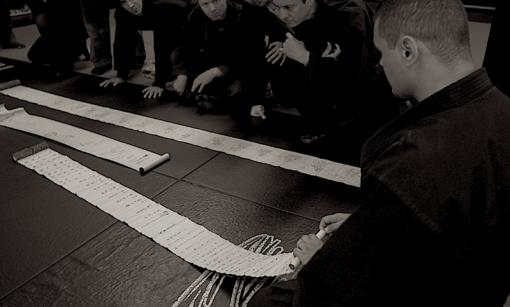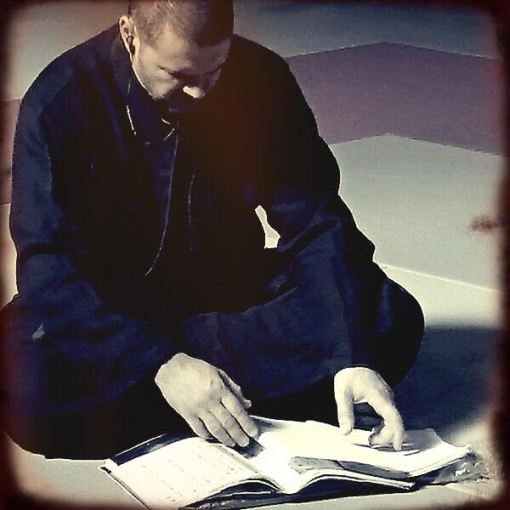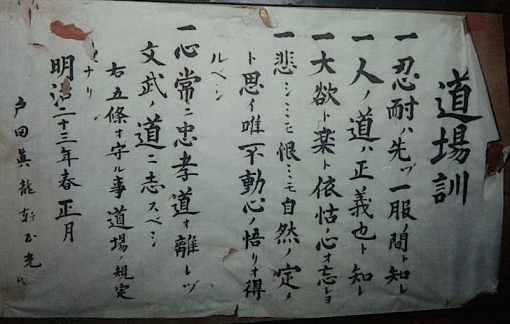
The importance of practicing the military arts as a means for character formation and practicing in military arts with a malevolent heart is perceived to be destructive; a mindset referred to as ‘the killing sword’. Practicing with the proper attitude, aimed at quelling hostilities and finding peaceful solutions, is referred to as the ‘life-giving sword’. The process of ‘musha shugyō’ is directed here at the practitioner’s awakening to the concept of ‘the life-giving sword’ and his fulfillment as a human being. Practice is aimed at gaining unparalleled superiority and strength over the enemy. However, it is a kind of strength that must not be revealed on the surface.
Similar interpretations of ‘the killing sword’ and ‘the life-giving sword’ can be found in the philosophies of later military arts traditions. However, preaching the ‘life-giving sword’ and putting it into practice are two different things. For example, the ‘Shintō-ryū’ provides an example of a military arts tradition which not only taught, but also uncompromisingly adhered to the principles of the ‘life-giving sword’ for half a millennium. There may have been others, but they did not endure and have been lost to history.
On the other hand, schools preaching that the final goal of one’s practice in the military arts lies in achieving a virtuous character (expressed in the ‘life-giving sword’ and consciousness), such as the famous ‘Yagyū Shinkage-ryū’, ‘Jigen-ryū’, ‘Maniwa Nen-ryū’, or ‘Ittō-ryū’, have left behind an extensive track record of duels, participation in wars, and killings by the order of ‘daimyōs’ (warlords / governors). For example, Tōgō Shigekata (1561-1643), the founder of Jigen-ryū, is said to have killed over ten people by the order of the Satsuma ‘daimyō’ while serving as the supreme teacher of swordsmanship in the Satsuma domain. Numerous duels and other feats of arms of the Yagyū family, which taught swordsmanship to the Tokugawa ‘shōguns’ for many generations, provide abundant material for popular storytelling and fiction. It is also suspected that the family was involved in the assassination of Noda Hankei, the famous swordsmith of the early Tokugawa era.
Moreover, we can find swordsmen of the pre- and early Tokugawa eras who, on the contrary, pursued only “the killing sword,” casting aside any humaneness under the pretext of ‘musha shugyō’. Such was the famous founder of the ‘Niten Ichi-ryū’ tradition (which also may be referred to as ‘Nitō Ichi-ryū’, ‘Emmei-ryū’, and other names), Miyamoto Musashi (1582-1645). He allegedly wrote that, by mastering ‘the virtue of the sword’, one masters the peaceful and orderly governance of a nation. Yet simulataneously, he is said to have murdered all his opponents in over 60 duels in a quest for victory over others.
To the critical eye, Musashi’s reckless striving for duels may be seen as a form of almost psychotic addiction to violence. However, uncritical academic and non-academic writers have raised Musashi to the status of an icon of the ‘bushi’, revering him as a ‘great master of swordsmanship’, or even a ‘saint swordsman’ (‘kensei’). This is without attaching any importance to the fact that he did not choose a means to engage in what he perceived as the process of self-perfection. Some scholars maintains that the Japanese cultural phenomenon of ‘musha shugyō’ reached its apogee in the life and career of Musashi. And, even though its authenticity is questioned, both scholars and popular writers have been preoccupied for generations with Musashi’s ‘Gorin no Sho’ (The Book of Five Rings, 1644), as well as with his personality, when considering ‘bushi’ moral values. Some argue that Musashi embodied the “Way of the Japanese people,”, even maintaining that ‘Gorin no Sho’, which is actually a treatise on the art of killing human beings, contains an image of a man that should serve as a model for people of the 21st century.
The impetus for the Musashi boom in Japan, and later overseas, was Yoshikawa Eiji’s novel ‘Miyamoto Musashi’ which was published as a newspaper serialization from 1935 to 1939. This serialization became a book in 1939, and it was also used for numerous theater and radio plays, TV and cinema films. The fictionalized image of Musashi has, through the process of repetition, become a historical reality in its own right. But, as Yoshikawa himself admitted, “there are almost no records about Musashi that could be trusted as true historical facts. If we are to summarize the truth about Musashi, it will take no more than 60-70 lines of printed text.” Apparently, few people know this and Musashi continues to be one of the most recognizable warrior figures in popular culture. His treatise on the art of killing has even become a manual for doing successful business among modern businessmen. Musashi has also been an object of reverence and commemoration in one of his supposed homelands in Mimasaka city, Okayama prefecture, where one can find a major practice center bearing his name. In Japan, modern ‘kendō’ tournaments are sometimes held in commemoration of Musashi.
It is necessary to establish an objective historical fact: Musashi did not kill his opponents in the righteous cause of, for example, defending his land against foreign aggressors, or fighting for his lord’s interests on the battlefield. His obsession with bloodshed was revealed through ‘polishing’ his sword skills by challenging others for individual duels. Musashi’s distorted notion of ‘musha shugyō’, or ‘self-perfection’, brought nothing but misfortune to his victims and their families. During his life he received ‘guest swordsman’ (‘kyakubun’) treatment from several ‘daimyōs’. However, his stipend was always much lower than that of other swordsmen in a similar position. He apparently sought to affiliate himself with the ‘Bakufu’ central government, but without success. This can be viewed as a social rejection of Musashi’s cruelty, which was regarded as excessive even in the early Tokugawa-era.








